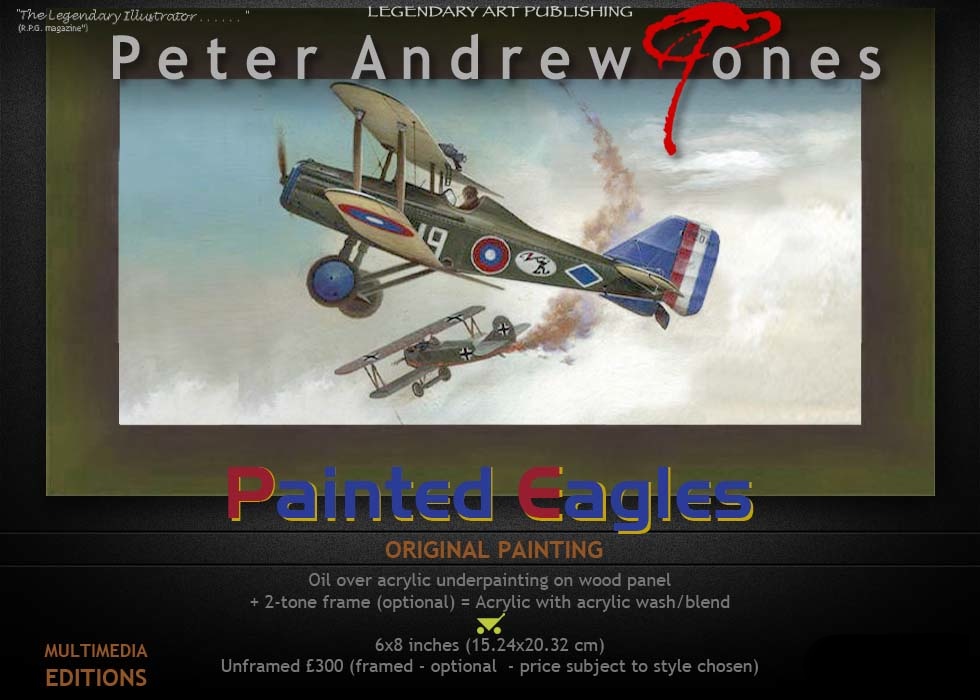
|
 A black executioner A black executioner
 By : Deborah Susan Jones : Editor By : Deborah Susan Jones : Editor
 "The
SE5a has turned out a dud . . . It's a great shame, for everybody
expects such a lot from them . . . it is a rotten machine." So wrote
the British Ace Albert Ball in the Spring of 1917 after re-positing
back to England from the War-torn Western Front together with an elite
group of pilots to form a new fighter group built around the crucially
important "Scout experimental 5." Certainly at that stage of the Great
War the German fighter aircraft were a very serious threat - faster -
more manoeuvrable - a higher ceiling and a quicker climb rate made them
deadly opponents that had to be stopped, but not everyone shared Ball's
view. "The
SE5a has turned out a dud . . . It's a great shame, for everybody
expects such a lot from them . . . it is a rotten machine." So wrote
the British Ace Albert Ball in the Spring of 1917 after re-positing
back to England from the War-torn Western Front together with an elite
group of pilots to form a new fighter group built around the crucially
important "Scout experimental 5." Certainly at that stage of the Great
War the German fighter aircraft were a very serious threat - faster -
more manoeuvrable - a higher ceiling and a quicker climb rate made them
deadly opponents that had to be stopped, but not everyone shared Ball's
view.
 Many
pilots considered the SE5a to be the best single-seat British fighter
aircraft of World War I. The first production aircraft from the design
factory at Farnborough was powered by a 150hp Hispano-Suiza engine and
were simply designated "The SE5a". Later models had a 200hp version of
the engine or a Wolseley Viper engine. Many
pilots considered the SE5a to be the best single-seat British fighter
aircraft of World War I. The first production aircraft from the design
factory at Farnborough was powered by a 150hp Hispano-Suiza engine and
were simply designated "The SE5a". Later models had a 200hp version of
the engine or a Wolseley Viper engine.
 Both
SE5 & SE5a models equipped twenty-four squadrons of the Royal
Flying Corps and Royal Air Force in France, Palestine, Macedonia,
Mesopotamia and the United Kingdom and also one of the Royal Australian
Air Force and two of the United States Air Service on the Western Front
and were associated with some of the War's most famous pilots;
Beachamp-Proctor, Bishop, Mannock and McCudden. Both
SE5 & SE5a models equipped twenty-four squadrons of the Royal
Flying Corps and Royal Air Force in France, Palestine, Macedonia,
Mesopotamia and the United Kingdom and also one of the Royal Australian
Air Force and two of the United States Air Service on the Western Front
and were associated with some of the War's most famous pilots;
Beachamp-Proctor, Bishop, Mannock and McCudden.
 To
counter the German superiority in the air, British Air Staff wanted a
fighter aircraft superior to that threat. Sopwith came up with the
legendary Camel and The Royal Aircraft Factory designed the "Scout
Experimental 5" and the first machine was tested by Albert Ball and his
negative views of the aircraft were reflective of his familiarity with
his slow but highly maneuverable Nieuport 17 but he was proved to be in
the minority given by the success of other pilots with the aircraft,
including Lt. Rhys-Davis who shot down Werner Voss, Richtofen's number
two ace, in the type. In fact the SE5 was a very stable gun platform
and was faster than Ball's Nieuport. To
counter the German superiority in the air, British Air Staff wanted a
fighter aircraft superior to that threat. Sopwith came up with the
legendary Camel and The Royal Aircraft Factory designed the "Scout
Experimental 5" and the first machine was tested by Albert Ball and his
negative views of the aircraft were reflective of his familiarity with
his slow but highly maneuverable Nieuport 17 but he was proved to be in
the minority given by the success of other pilots with the aircraft,
including Lt. Rhys-Davis who shot down Werner Voss, Richtofen's number
two ace, in the type. In fact the SE5 was a very stable gun platform
and was faster than Ball's Nieuport.
 The
painting shows an SE 5a in United States Air Service markings. My
graphic design training was probably what initially attracted me to the
emblem of the 25th Aero Squadron of the United States Air Service, a
caricatured executioner, which lead me then to make this painting
concerning an SE5a flown by pilot Reed Gresham Landis (1896 - 1975) but
gaining any really accurate information about him, the unit or the
markings had been a long-running effort. As ever, my entry into "the
realm of knowledge" about an aircraft, and most especially its
markings, are entirely from excitement about the visual aspect, rather
than initially any historical research, which always then follows. I am
always fascinated about the historical timeline that causes my pictures
to happen - Bishop, McCudden, Mannock, such were certainly the names
associated with this aeroplane and yet it was the colourful markings of
the 25th Aero Squadron that caught my eye when applied to this classic
plane, created by H.P. Folland's design team; perhaps that this
painting exists at all was because the plane was easy to fly and so,
when passed to forces outside the RAF as a "trusted steed of the air"
it avoided, whether by design or default, any knock-on problems once in
other hands, be they experienced or not as the case may have been, the
markings and the plane thus come together, while its contemporary, the
Sopwith Camel, being a "bitch of the air" in contrast that the
Americans did not like at all, perhaps denied me the opportunity, at
least until I discover one, of striking US markings on another W.W.I
British front line fighter? The
painting shows an SE 5a in United States Air Service markings. My
graphic design training was probably what initially attracted me to the
emblem of the 25th Aero Squadron of the United States Air Service, a
caricatured executioner, which lead me then to make this painting
concerning an SE5a flown by pilot Reed Gresham Landis (1896 - 1975) but
gaining any really accurate information about him, the unit or the
markings had been a long-running effort. As ever, my entry into "the
realm of knowledge" about an aircraft, and most especially its
markings, are entirely from excitement about the visual aspect, rather
than initially any historical research, which always then follows. I am
always fascinated about the historical timeline that causes my pictures
to happen - Bishop, McCudden, Mannock, such were certainly the names
associated with this aeroplane and yet it was the colourful markings of
the 25th Aero Squadron that caught my eye when applied to this classic
plane, created by H.P. Folland's design team; perhaps that this
painting exists at all was because the plane was easy to fly and so,
when passed to forces outside the RAF as a "trusted steed of the air"
it avoided, whether by design or default, any knock-on problems once in
other hands, be they experienced or not as the case may have been, the
markings and the plane thus come together, while its contemporary, the
Sopwith Camel, being a "bitch of the air" in contrast that the
Americans did not like at all, perhaps denied me the opportunity, at
least until I discover one, of striking US markings on another W.W.I
British front line fighter?
 Thus
it is that I end up being inspired by markings that might not otherwise
have existed on this plane. I like that sort of timeline in my Art. If
you do know of any great looking Camels that have such an interesting
visual lineage I'd love to see the reference material, always worth
reflecting on for a potential painting! Thus
it is that I end up being inspired by markings that might not otherwise
have existed on this plane. I like that sort of timeline in my Art. If
you do know of any great looking Camels that have such an interesting
visual lineage I'd love to see the reference material, always worth
reflecting on for a potential painting!
 Reed
Landis is credited with nine enemy aircraft and one kite balloon and
the bulk of his training and front-line experience was with the Royal
Flying Corps' no. 40 Squadron, a unit that also produced Mick Mannock
and Captain G.E.H. McElroy and as far as I have managed to research
Landis' score was achieved solely while with 40 Squadron, but this is
open to conjecture. Reed
Landis is credited with nine enemy aircraft and one kite balloon and
the bulk of his training and front-line experience was with the Royal
Flying Corps' no. 40 Squadron, a unit that also produced Mick Mannock
and Captain G.E.H. McElroy and as far as I have managed to research
Landis' score was achieved solely while with 40 Squadron, but this is
open to conjecture.
 Landis
was born July 17, 1896 and by the time he was twenty years old was
enlisted as a private in the 1st Illinois Cavalry and served on the
Mexican Border but in early 1917 transferred to the aviation section of
the Signal Corps and after completing ground school tests was sent to
England for flight training. Landis
was born July 17, 1896 and by the time he was twenty years old was
enlisted as a private in the 1st Illinois Cavalry and served on the
Mexican Border but in early 1917 transferred to the aviation section of
the Signal Corps and after completing ground school tests was sent to
England for flight training.
 His
RAF career has received little publicity but we can say that at least
most of his active service was spent with 40 Squadron on the SE5a even
if we know little of the details of this deployment. He seems then to
have been posted from the Front back to England to join the 25th Aero
Squadron which was newly forming and then was sent to be part of the
new 4th Pursuit Group with Landis being promoted to the rank of Major,
but whether he took part in any meaningful front-line patrols or fights
is unclear, at least to me. His
RAF career has received little publicity but we can say that at least
most of his active service was spent with 40 Squadron on the SE5a even
if we know little of the details of this deployment. He seems then to
have been posted from the Front back to England to join the 25th Aero
Squadron which was newly forming and then was sent to be part of the
new 4th Pursuit Group with Landis being promoted to the rank of Major,
but whether he took part in any meaningful front-line patrols or fights
is unclear, at least to me.
 He was awarded the D.F.C. by the
British and the D.S.C. by his own country. He was awarded the D.F.C. by the
British and the D.S.C. by his own country.
 After
the Great War he worked as a pioneer in civilian aviation with American
Airlines, served as chairman of the American Legion and later
established and Advertising Agency in Chicago called The Reed G. Landis
Company. After
the Great War he worked as a pioneer in civilian aviation with American
Airlines, served as chairman of the American Legion and later
established and Advertising Agency in Chicago called The Reed G. Landis
Company.
 World War II recalled Landis to the US
Army Air Force in 1942 in which he eventually reached the rank of
Colonel. World War II recalled Landis to the US
Army Air Force in 1942 in which he eventually reached the rank of
Colonel.
 He has previously published his memoirs
in 1919 titled On the Roof of the War. He has previously published his memoirs
in 1919 titled On the Roof of the War.
 He died at the age of 78 in May 1975 in
Arkansas. He died at the age of 78 in May 1975 in
Arkansas.
 Deborah Susan Jones : Editor Deborah Susan Jones : Editor
|
 |







